After our post two weeks ago about the Panda 4.0 update, we had a couple of websites hit pretty hard rankings wise, so we followed some of the best recovery guides out there and thought we’d share what we did, how we did it, and what results have been achieved so far.
You can read our first post here to see the impact the Panda 4.0 update had on this particular website’s rankings.
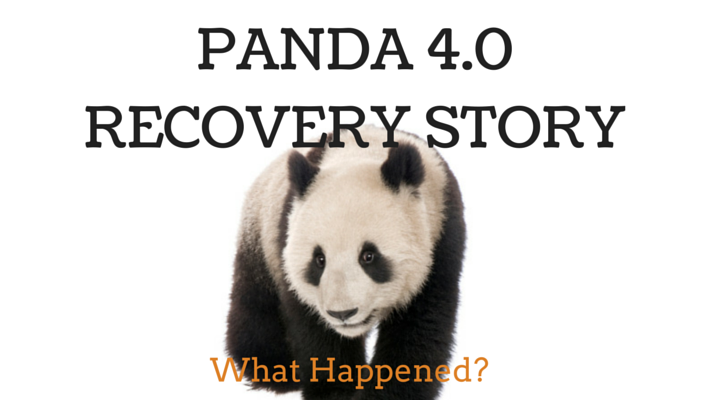
So What Happened?
As you can see from the images below, rankings dropped.
Hard.
But, after making making the necessary content, structure and usability changes to the website, you can see the huge recovery on June 6th.
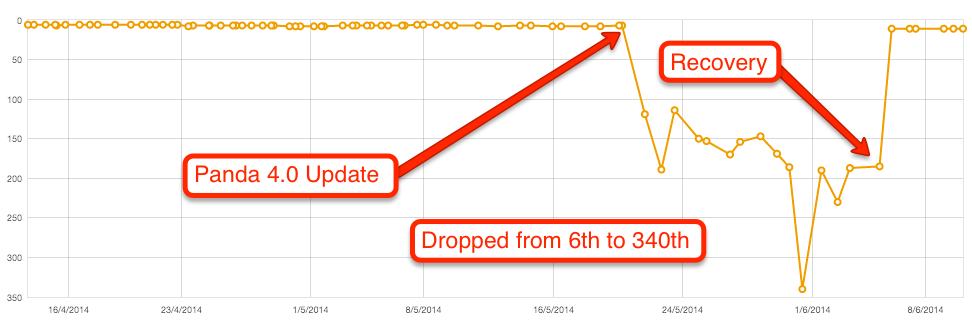
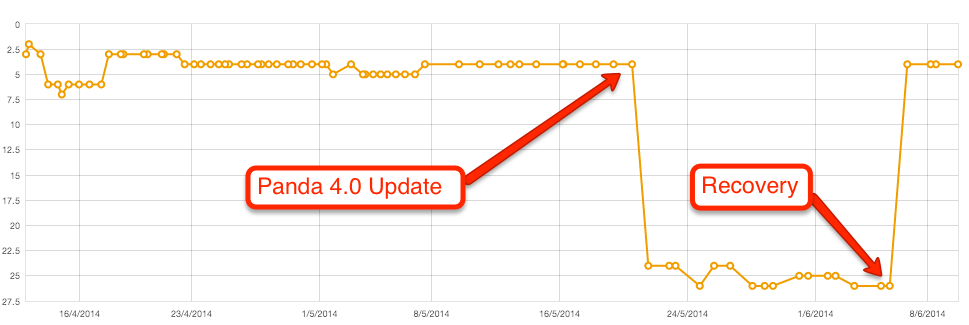
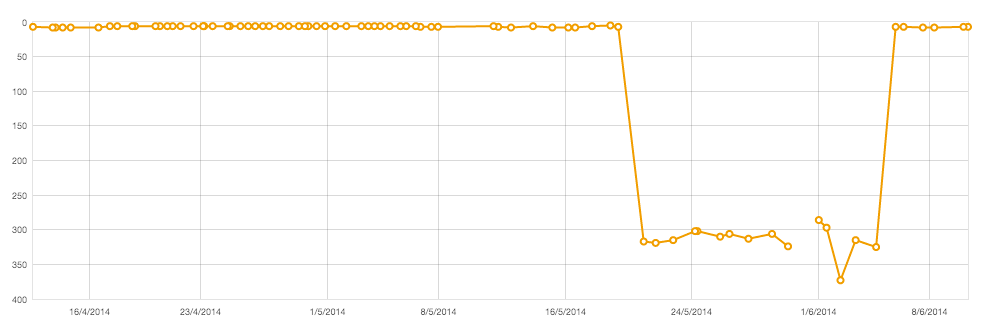
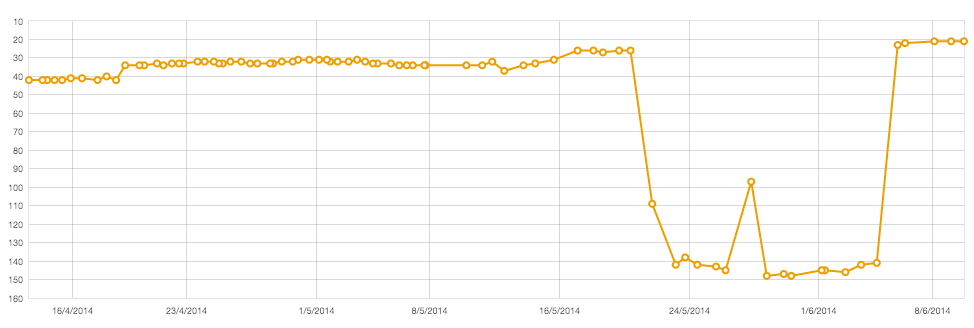
So What Did We Do?
Firstly, we read this epic Panda 4.0 analysis by Glen Gabe which outlines what you need to do if you’re hit by a Panda update.
We went with the “Nuclear” option which involved dramatic changes to the website content, structure, layout and coding.
We were weary of time so we wanted to act quickly so the website would have all necessary changes made before the next Panda 4.0 refresh.
If your site has been hit by any Panda update, be sure to read that guide and determine the best course of action for your website.
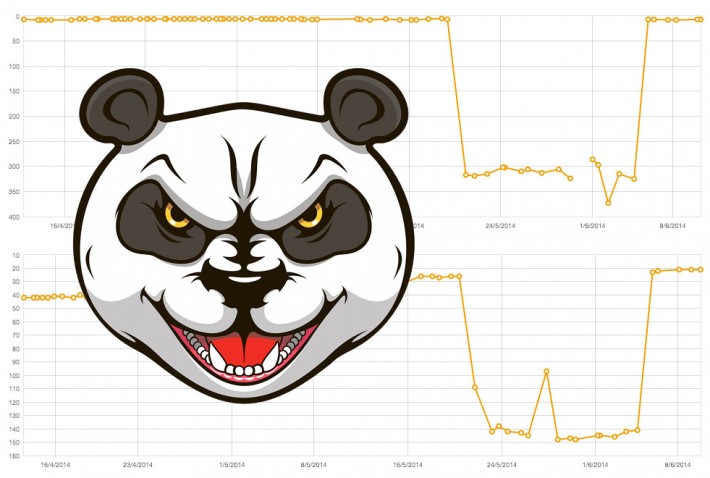
The Steps We Took
The following are the steps that were taken to recovery from the Panda 4.0 update.
Please note, the steps for each site will be different depending on what was causing your site to trigger the filter. In our case, we identified that this website had a reasonable amount of duplicate information, ‘thin’ content pages and poor user experience in some areas.
1. Deindexed Pages & Removed ‘Cookie Cutter’ pages
We had a number of custom contact forms that had their own individual pages that were slightly different. After closer inspection, these did not need to be indexed by Google and were essentially duplicated across the website.
Unfortunately, some of the pages on this particular website could also be considered ‘cookie cutter’ pages (the same content with only minor changes) which probably deserved to get hit.
These had been on the site for a couple of years without any problem, but this Panda whack gave us the kick up the bum that we needed to beef up those pages and give their customers a much better user experience.
We used Yoast’s WordPress SEO plugin and “no indexed” them so they would be removed from Google’s index.

2. Deleted / Rolled Duplicate or Similar Pages in One Page
After going through and de-indexing redundant pages, we then did a content audit of the site and realised a number of the main content pages were all fairly similar in content and layout.
When the website was made a few years ago, we felt they each deserved their own individual pages (as they doubled as landing pages for the Google Adwords campaigns), but after thoughtful discussion with our client, we decided that there was no reason that a number of these couldn’t be merged into the same page.
We ended up cutting the number of pages by about 15%.
3. Added Additional and Better Quality Content to all Pages
After closer inspection of the information on a number of the content pages, we realised that there was a fairly low word count (around 200 words), and not a whole lot of extra value added from page to page. We decided to beef these up with better information and more engaging sales copy.
So we went through and:
- added additional dot points
- changed the layout of the pages
- added images and other visual elements
- improved the readability of the pages
- added headlines and sub headlines to break up content
- added links to relevant other content pages
4. Simplified the Lead Generation Process and Improved Page Layouts
The key was determining what this client’s customer actually wanted when they arrived at the site – and we tailored each page to that. We simplified the lead generation process by adding shorter enquiry forms embedded in the page, rather than forcing the user to add an extra click to go to a custom enquiry form relating to that particular content page.
This improved the overall user experience and has significantly improved the conversion rates of the website both for organic visitors, and the Adwords campaigns that were running.
The client then came to the realisation that they were missing out on a large number of enquiries just due to the inefficient page layout and longer than necessary lead generation forms.
It was initially thought that this extra information was needed, but after closer analysis, a more simplified enquiry form asking for basic contact details was a far better option so they could use their excellent phone sales team (which is their strength) to close the sale.
5. Improved Navigation Structure
We simplified and streamlined the navigational structure and reduced the number of navigation levels down to just two (instead of three) and combined several of the deeper pages into larger common themed pages.
We also removed a number of redundant and poor performing pages from the navigation.
6. Improved Load times
Another high priority was to improve the speed of the website. We used a caching plugin, optimised images, and cleaned up the website’s code to make it cleaner.
7. Acted Quickly
We wanted to get in quickly before the next Panda refresh – and we were successful.
Learnings
Fortunately, this site already had:
- Good on page SEO factors
- Used responsive web design
- Reasonably well coded
- Used WordPress
- Good local visibility
- A solid brand in the market

This made the process a little bit easier as it didn’t take a huge amount of time to locate what we thought was triggering the Panda algorithm.
Panda 4.0 Recovery Results
You can see the rankings recovery on the image to the right.
We were fortunate that the rankings bounced back pretty quickly and traffic returned as well.
Panda 4.0 Actually Helped this Website
Now this might seem a bit strange, but it is the truth.
The Panda 4.0 update destroyed this site’s rankings and traffic, but it was also a massive wake up call to us and our client.
It forced us both to:
- Focus on the user experience
- Improve the content on the website
- Create better page layouts
- Get a better understanding of the client’s sales strategy – realised they didn’t require as much information on an enquiry form and more phone calls = more sales
- Determine what their customers really wanted and needed
- Eventually improve conversion rates and overall enquiries
Conclusion
Panda updates can have a devastating affect on any website’s ranking and traffic.
It can be a challenging to identify exactly what is causing a website to get hit, but once you do, it is important to act quickly and smartly to make the necessary changes to your website.
The good news is that for local businesses, you can bounce back to previous rankings (or even better) as evidenced by this case study.
It is always a good idea to keep on top of your website’s content, layout and user experience to ensure that these updates don’t have a negative impact on your website.
